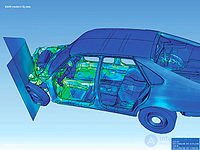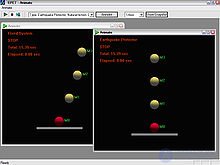Lecture

A computer model ( computer model ), or a computational model (computer model ) is a computer program running on a single computer, supercomputer, or a set of interacting computers (computing nodes) that implements a representation of an object, system, or concept in a form other than real , but close to the algorithmic description, including a set of data describing the properties of the system and the dynamics of their changes over time. [1] Computer models have become a common tool for mathematical modeling and are used in physics, astrophysics, mechanics, chemistry, biology, economics, sociology, meteorology, other sciences and applied problems in various fields of radio electronics, engineering, automotive and so on. Computer models are used to obtain new knowledge about the object being modeled or to approximate the behavior of systems that are too complex for analytical research.
Computer modeling is one of the effective methods for studying complex systems. Computer models are easier and more convenient to explore because of their ability to carry out the so-called. computational experiments, in cases where real experiments are difficult due to financial or physical obstacles or can give unpredictable results. The consistency and formality of computer models allows determining the main factors determining the properties of the original object under study (or a whole class of objects), in particular, to investigate the response of the simulated physical system to changes in its parameters and initial conditions.
The construction of a computer model is based on abstraction from the specific nature of the phenomena or the original object under study and consists of two stages — first, the creation of a qualitative, and then a quantitative model. The more significant properties will be revealed and transferred to the computer model - the more approximate it will be to the real model, the greater the capabilities that the system using this model will have. [1] Computer simulation is to conduct a series of computational experiments on a computer, the purpose of which is to analyze, interpret and compare the simulation results with the actual behavior of the object being studied and, if necessary, the subsequent refinement of the model, etc.

The main stages of computer modeling include:
There are analytical and simulation modeling. In analytical modeling, mathematical (abstract) models of a real object are studied in the form of algebraic, differential, and other equations, as well as providing for an unambiguous computational procedure leading to their exact solution. In simulation, mathematical models are investigated in the form of an algorithm (s) that reproduces the functioning of the system under study by sequentially performing a large number of elementary operations.
Computer simulation is used for a wide range of tasks, such as:
Different applications of computer models impose different demands on the reliability of the results obtained with their help. The modeling of buildings and aircraft parts requires high accuracy and reliability, while models of the evolution of cities and socio-economic systems are used to obtain approximate or qualitative results.
Comments
To leave a comment
System modeling
Terms: System modeling